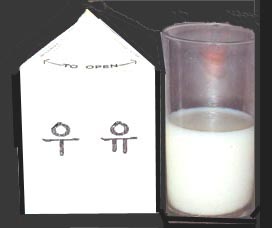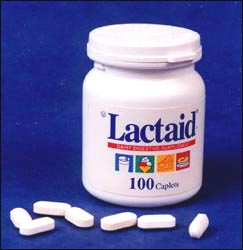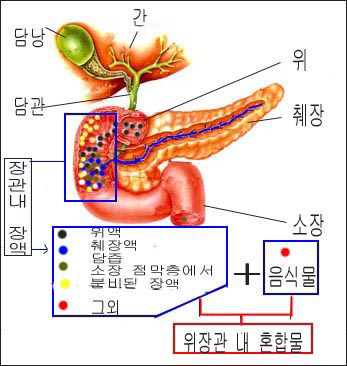2차 유당 불내증으로 생기는 설사 Diarrhea caused by secondary lactose intolerance

사진 68. 유당 불내증 으로 설사할 수 있다.
우유 속에 유당이 들어있다. 소장관 점막층에서 락타제 유당효소가 분비되지 않으면 유당불내증 이 생길 수 있다.
Copyright ⓒ 2011 John Sangwon Lee, MD., FAAP

사진 69. 유당 불내증 이 있는 소아청소년들이나 성인들이 유당이 든 우유나 우유가 든 음식물을 먹을 때마다 인공 유당 효소제, 랙트에이드(Lactaid)를 동시 복용하면 유당이 어느 정도 소화될 수 있다.
Copyright ⓒ 2011 John Sangwon Lee, MD., FAAP
- 유당 효소 부족 또는 결핍으로 생기는 증상 징후를 유당 불내증이라고 한다.
- 선천적으로 생기는 유당 불내증을 1차성 유당 불내증 또는 선천적 유당 불내증이라 하고 후천적으로 생기는 유당 불내증을 2차성 유당 불내증 또 후천성 유당 불내증이라 한다.
- 출생 이후부터 3~4세가 될 때까지 거의 모든 신생아들, 영유아들의 소장관 점막층에서 락타아제(Lactase) 유당 효소가 정상적으로 분비된다.
- 소장관 벽 점막층에서 분비되는 유당 효소 락타제는 유당을 갈락토오스(Galactose)와 포도당(Glucose)으로 분해시키는 효소역할을 한다.
- 영아기 이후 대부분의 백인종 유아들, 학령기, 사춘기 아이들과 성인들의 소장관 벽 점막층에서 유당 효소가 계속 분비된다.
- 그러나 대부분의 황인종 아이들과 흑인종 아이들이 1~6세가 된 이후부터 소장관 벽 점막층에서 유당 효소가 더 이상 분비되지 않는 것이 보통이다.
- 이렇게 선천적으로 유당 효소가 소장관 벽 점막층에서 분비되지 않아 생긴 유당 효소 부족증을 1차성 선천성 유당 효소 부족증, 또는 선천성 유당 효소 부족증이라고 한다. 선천성 유당 불내증으로 생기는 설사 참조.
- 유당 효소가 정상적으로 소장관 벽 점막층에서 충분히 분비될 때 모유, 유당이 든 인공영양, 전 우유(Whole milk), 또는 우유가 든 음식물을 먹는 신생아들, 영유아들에게는 모유나 유당이 든 음식물에 있는 유당은 유당 효소, 락타제 작용으로 소장관 내에서 포도당과 갈락토오스로 분해되는 것이 정상이다.
- 이 때 장관 내에 생긴 포도당과 갈락토오스는 소장관 벽점 막층을 통과해 혈관 내 핏속으로 흡수되어 에너지의 자원으로 쓰이는 것이 정상적이다.
- 경구용 항생제로 어떤 병을 치료할 때나, 로타바이러스 감염 등 바이러스 감염병, 박테리아 감염병으로 위장염이 생길 때 소장관 벽 점막층이 일시적으로 손상될 수 있고 손상된 소장관 벽 점막층에서 유당 효소 락타아제가 일시적으로 분비되지 않을 수 있다. 태어날 때는 유당 효소가 모든 신생아들의 소장관 벽 점막층에서 정상적으로 분비되지만 경구용 항생제 치료를 받거나 위장염 등으로 소장관 벽 점막층이 손상될 때 유당 효소 부족이 생길 수 있다. 그때 생긴 병을 2차성 유당 효소 부족증, 후천적 유당 효소 부족증, 또는 2차성 유당 불내증이라 한다.

그림 67. 장관 속 장액에는 담즙, 췌장액, 장액, 위액, 체액, 각종 미네랄과 전해질, 수분, 먹은 음식물 등이 섞여 있다. 간장, 췌장에 있는 어떤 이상으로 설사를 할 수 있다.
Copyright ⓒ 2011 John Sangwon Lee, MD., FAAP
- 2차성 유당 불내증이 있을 때는 유당 효소가 일시적으로 부족 되든지, 일시적으로 아주 분비되지 않는 상태가 얼마동안 지속될 수 있다.
- 그 때문에 먹은 우유에 든 유당이 소장관 속에서 정상적으로 소화되지 않고 소장관 속에 있는 상존 박테리아 균상으로 부패되고, 거기서 유산·이산화탄소·수소 등이 생기게 된다.
- 이렇게 생긴 수소, 유산과 이산화탄소 등 가스로 소장관이 자극받아 위장 연동운동이 항진되고 또 위장관 속 혼합물의 삼투압이 증가되어 삼투압성 설사(Osmotic diarrhea)를 하게 되고, 또 이산화탄소가스 등 가스가 위장관 속에 많이 생겨 방귀를 많이 뀌게 되고 배가 불러질 수 있다.
- 유당 효소가 일시적으로 감소되거나 아주 없을 때 모유, 우유, 또는 유당이 든 인공영양을 섭취하면 소장관 속에서 유당이 제대로 소화될 수 없고 유당이 포도당과 갈락토오스로 분해될 수 없고 방귀, 헛배 부름, 복통, 설사를 하게 된다.
- 우유 단백질이 든 인공영양을 먹었을 때 하는 설사 참조.
- 유당 효소가 부족하거나 결핍증으로 오는 설사의 증상 징후는 다양하다.
- 여기서는 2차성 유당 효소 부족으로 오는 유당 불내증의 증상 징후에 관해 주로 설명한다.
- 2차성 유당 불내증이 생기게 한 원발성(1차성) 병으로 생긴 증상 징후와 2차성 유당 불내증으로 생기는 증상 징후가 함께 나타난다.
- 유당이 든 우유, 인공영양, 또는 유당이 든 음식물을 먹을 때 소장관 속에 가스가 많이 차서 배가 팽만해지고, 자주 방귀 뀐다.
- 설사와 복통이 생기고 심할 때에는 구토하고 성장지연이 생길 수 있다.
- 병력·증상 징후·진찰소견 등을 종합해서 2차성 유당 불내증을 진단할 수 있다.
- 숨을 들이쉬고 내쉴 때 내쉬는 공기 속에 있는 수소의 농도를 측정해서 유당 효소 부족증을 진단할 수 있고, 대변검사 또는 일정 양의 유당을 경구로 섭취한 후 일정한 시간이 지난 후에 혈당을 측정해서 진단할 수 있다.
- 2차성 유당 불내증을 일으킨 원인을 근본적으로 치료한다.
- 유당 효소가 다시 충분히 분비될 때까지 우유나 유당이 든 인공영양이나 우유 음식물을 일절 섭취하지 말아야 한다.
- 유당이 든 음식물을 먹을 때마다 인공 락타아제(인공 유당 효소)를 복용하면 이 병의 증상이 덜할 수 있다.
- 매일 우유나 우유가 든 음식물을 먹을 때마다 인공 유당 효소, 락타제를 먹으면, 차후에 위장이나 신체의 다른 계통의 다른 부위에 어떤 문제가 생길지 아직 잘 모르기 때문에 인공 유당 효소를 매일 장기간 먹는 것도 권장하지 않는다.
Diarrhea caused by secondary lactose intolerance 2차 유당 불내증으로 생기는 설사

Picture 68. Lactose intolerance can cause diarrhea. There is lactose in the milk. Lactose intolerance may occur if lactase lactose enzyme is not secreted from the mucous membrane of the small intestine. Copyright ⓒ 2011 John Sangwon Lee, MD., FAAP

Picture 69. Lactose can be digested to some extent by taking an artificial lactose enzyme, Lactaid, whenever children or adults with lactose intolerance eat milk or milk-containing food. Copyright ⓒ 2011 John Sangwon Lee, MD., FAAP
• Signs of symptoms resulting from a lack or deficiency of lactose enzymes are called lactose intolerance.
• Congenital lactose intolerance is called primary lactose intolerance or congenital lactose intolerance, and acquired lactose intolerance is called secondary lactose intolerance or acquired lactose intolerance.
• From birth to the age of 3-4, almost all newborns, infants and toddlers secrete lactase lactase normally from the mucous membrane of the small intestine.
• Lactose enzyme lactase secreted from the mucous membrane of the small intestine wall acts as an enzyme that breaks down lactose into galactose and glucose.
• After infancy, lactose enzymes continue to be secreted in the mucous membrane of the small intestine wall of most Caucasian infants, school-age, adolescent children and adults. • However, it is common for most yellow and black children to no longer secrete lactose enzymes from the mucous membrane of the small intestine after the age of 1-6.
• Lactose enzyme deficiency caused by the innate lactose enzyme being secreted from the mucous membrane of the small intestine is called primary congenital lactose enzyme deficiency or congenital lactose enzyme deficiency. See diarrhea resulting from congenital lactose intolerance.
• When lactose enzymes are normally secreted sufficiently from the mucous membrane of the small intestinal tract, breast milk, artificial nutrition with lactose, whole milk, or newborns who eat foods containing milk, and infants with breast milk or lactose-containing foods. It is normal for lactose to be decomposed into glucose and galactose in the small intestine through the action of lactose enzymes and lactase.
• At this time, it is normal for glucose and galactose generated in the intestine to pass through the mucous membrane of the small intestine and be absorbed into the blood vessels and used as energy resources.
• When treating certain diseases with oral antibiotics, or when gastroenteritis occurs due to viral or bacterial infections such as rotavirus infection, the mucous membrane of the small intestine may be temporarily damaged, and the lactose enzyme lactase is temporarily not secreted from the mucous membrane of the intestinal tract. May not. At birth, lactose enzymes are normally secreted from the mucous membrane of the intestinal tract of all newborns, but a lack of lactose enzymes can occur when the mucous membranes of the intestinal tract are damaged by oral antibiotic treatment or gastroenteritis. The resulting disease is called secondary lactose enzyme deficiency, acquired lactose enzyme deficiency, or secondary lactose intolerance.

Figure 67. Intestinal fluid contains bile, pancreatic fluid, intestinal fluid, gastric fluid, body fluid, various minerals and electrolytes, water, and food eaten. Any abnormalities in the liver or pancreas can cause diarrhea. Copyright ⓒ 2011 John Sangwon Lee, MD., FAAP
• When you have secondary lactose intolerance, the lactose enzyme may be temporarily deficient or temporarily very low-key for some time.
• Because of this, the lactose in the milk eaten is not digested normally in the small intestine, but decays into the existing bacterial flora in the small intestine, where lactic acid, carbon dioxide, and hydrogen are produced.
• The gastrointestinal peristalsis is stimulated by gases such as hydrogen, lactic acid and carbon dioxide, which promotes gastrointestinal peristalsis, and the osmotic pressure of the mixture in the gastrointestinal tract increases, leading to osmotic diarrhea, and gases such as carbon dioxide gas into the gastrointestinal tract. There are a lot of them, which can lead to a lot of farts and bloating.
• Ingestion of breast milk, milk, or artificial nutrition with lactose when lactose enzymes are temporarily reduced or absent can cause lactose to be poorly digested in the small intestine, lactose cannot be broken down into glucose and galactose, farts, flatulence, You will have abdominal pain and diarrhea.
• See diarrhea from eating artificial nutrients containing milk protein.
• Signs of diarrhea due to a lack or deficiency of lactose enzymes vary.
• This section mainly describes the symptoms of lactose intolerance due to a lack of secondary lactose enzymes.
• Symptoms resulting from the primary (primary) disease causing secondary lactose intolerance and symptoms resulting from secondary lactose intolerance appear together.
• When eating milk with lactose, artificial nutrients, or foods containing lactose, the gas in the small intestine fills up with a lot of gas, causing the stomach to bloat and frequent farts.
• Diarrhea and abdominal pain may occur, and in severe cases, vomiting and growth delay may occur. • Secondary lactose intolerance can be diagnosed by synthesizing medical history, symptoms, and examination findings.
• Lactose enzyme deficiency can be diagnosed by measuring the concentration of hydrogen in the exhaled air when inhaling and exhaling. It can be diagnosed by measuring blood sugar after a certain period of time after a stool test or oral intake of a certain amount of lactose. I can.
• Fundamentally treat the cause of secondary lactose intolerance.
• Do not consume milk or any artificial nutrition or milk foods containing lactose until enough lactose enzymes are released.
• Taking artificial lactase (artificial lactose enzyme) each time you eat foods containing lactose may reduce the symptoms of the disease.
• It is not recommended to take artificial lactose enzymes daily for long periods of time, since taking artificial lactose enzymes, lactases, and other parts of the body, such as the stomach or other parts of the body, are not known. Does not.
출처 및 참조 문헌 Sources and references
- NelsonTextbook of Pediatrics 22ND Ed
- The Harriet Lane Handbook 22ND Ed
- Growth and development of the children
- Red Book 32nd Ed 2021-2024
- Neonatal Resuscitation, American Academy Pediatrics
- www.drleepediatrics.com제7권 소아청소년 감염병
- www.drleepediatrics.com제9권 소아청소년 소화기 질환
- Red book 29th-31st edition 2021
- Nelson Text Book of Pediatrics 19th — 21st Edition
- The Johns Hopkins Hospital, The Harriet Lane Handbook, 22nd edition
-
Childhood Emergencies in the Office, Hospital and Community, American Academy of Pediatrics
-
Emergency Medical Service for Children, By Ross Lab. May 1989. p.10
-
Emergency care, Harvey grant, and Robert Murray
-
Emergency Care Transportation of Sick and Injured American Academy of Orthopaedic Surgeons
-
Emergency Pediatrics A Guide to Ambulatory Care, Roger M. Barkin, Peter Rosen
-
Immediate care of the acutely ill and injured, Hugh E. Stephenson, Jr
-
The Critically Ill Child, Diagnosis and Management, Edited by Clement A. Smith
-
Emergency Medical Services for Children: The Role of the Primary Care Provider, America Academy of Pediatrics
-
Quick Reference To Pediatric Emergencies, Delmer J. Pascoe, M.D., Moses Grossman, M.D. with 26 contributors
-
Manual of Emergency Care
-
응급환자관리 정담미디어
-
소아가정간호백과–부모도 반의사가 되어야 한다, 이상원
-
Neonatal Resuscitation American heart Association
-
Neonatology Jeffrey J.Pomerance, C. Joan Richardson
-
Pediatric Resuscitation Pediatric Clinics of North America, Stephen M. Schexnayder, M.D.
-
Pediatric Critical Care, Pediatric Clinics of North America, James P. Orlowski, M.D.
-
Preparation for Birth. Beverly Savage and Dianna Smith
- Infectious disease of children, Saul Krugman, Samuel L Katz, Ann A. Gershon, Catherine Wilfert
-
The Harriet Lane Handbook 19th Edition
-
소아과학 대한교과서
-
제1권 소아청소년 응급의료 참조문헌과 출처
-
Other
Copyright ⓒ 2015 John Sangwon Lee, MD., FAAP
“부모도 반의사가 되어야 한다”-내용은 여러분들의 의사로부터 얻은 정보와 진료를 대신할 수 없습니다.
“The information contained in this publication should not be used as a substitute for the medical care and advice of your doctor. There may be variations in treatment that your doctor may recommend based on individual facts and circumstances. “Parental education is the best medicine.”